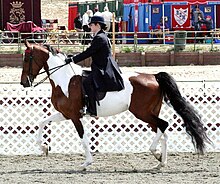National_Show_Horse
National Show Horse
American breed of horse
The National Show Horse originated as a part-Arabian cross between an American Saddlebred and an Arabian horse. It is now established as a separate breed, since the founding of a breed registry in August 1981.[1] Registered animals today may be the offspring of registered NSH parents or may be a combination between an American Saddlebred, Arabian, and a National Show Horse. Non-NSH mares and stallions must be registered with their appropriate registries, and stallions who are Arabian or Saddlebred must additionally be nominated and approved by the NSHR board of directors. Although any combination of these three breeds may be used, as of December 1, 2009 there must be at least 50% Arabian blood in the horse to be registered, up to 99% Arabian blood (formerly 25% minimum Arabian blood was required for registry).[1][2]
This article has multiple issues. Please help improve it or discuss these issues on the talk page. (Learn how and when to remove these template messages)
|
